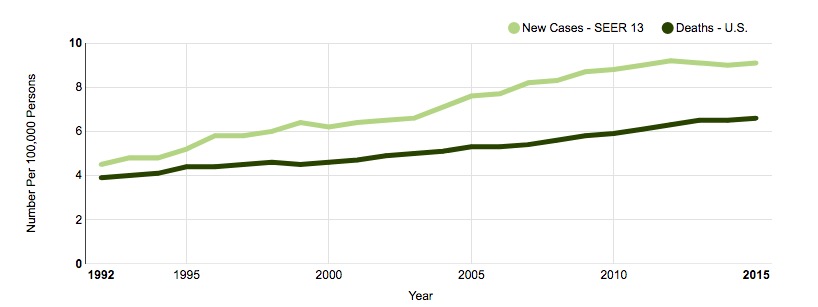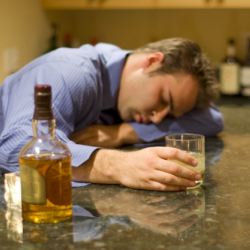As I've written before, drug companies, no matter how revolutionary a discovery they make, cannot control human behavior. Antiretroviral drugs, which decrease levels of HIV to such low levels that it cannot be transmitted have made unprotected sex "safe." But while it may keep you safe from HIV, this does not hold true for other sexually transmitted diseases (STDs). The decreased use of condoms resulted in a huge spike (1) in other sexually transmitted diseases, especially syphilis and gonorrhea.
In a way, history is repeating because once again, we are looking at unintended consequences. This time, a spike in deaths from liver cancer caused by a huge increase in drinking by young Americans is negating a reduction in these cancers by drugs that cure hepatitis C.
Before the development of hepatitis C drugs that provided an easy cure in the vast majority of infected patients (See Hepatitis C: Academia And Industry Work Together To Find A Cure) cirrhosis and hepatocarcinoma (liver cancer), both of which result from long-term infection of the liver by the virus (HCV), made hepatitis C the leading cause of liver transplants in the US.
Figure 1 (below) shows the incidence (number of new cases per year) of liver cancer from 1992-2015. There is a steep rise from 1992-2012, after which there is a plateau.

Figure 1. Incidence and mortality of liver cancer, 1992-2015. Source: National Cancer Institute
Why the plateau? It is impossible to be sure, but here's one possibility (Figure 2). The uptick in cases stopped one year after the approval of the approval of Incivek, the first direct-acting antiviral drug for hepatitis C infection. Sovaldi, which was superior to Incivek (no longer sold) came along two years later, followed by a number of even better HCV drugs since then. Cure rates range from 90-100% depending on the strain of the virus.

So, even if the plateau cannot be positively attributed to the new drugs it is a reasonable hypothesis, as is the prediction that these numbers will continue to fall since liver cancer results from chronic inflammation and cirrhosis, both of which are caused by HCV, right? No, not right.
Drugs can only do so much, especially when they're up against destructive behavior. And there is plenty of that right now. Americans are drinking so much that any benefit of the hepatitis C drugs will be swamped by self-induced cirrhosis and the liver cancer it can cause.
"Although hepatitis C virus, a major cause of cirrhosis, could be eradicated given the recent advent of widely available and highly effective antiviral therapy, this [increasing] trend is likely to continue."
E. B. Tapper and N. D. Parikh BMJ 2018; 362 doi: https://doi.org/10.1136/bmj.k2817
But it's not the Baby Boomers - the group that has been hit especially hard by HCV infection - that is driving up the incidence of cirrhosis. It is a younger group, those aged 25-34, that is responsible, and according to a recent paper in BMJ, they're doing one helluva job.
Between 2009-2016 deaths from cirrhosis climbed by 3.4% annually in the US, but in the 25-34 drinkers managed to outdo this and not by a little. During that time deaths due to cirrhosis in this group rose by 10.5% (!) annually. This number is especially alarming because cirrhosis (scarring of the liver) develops irreversibly over time. This means that people in this age group who drank heavily but did not die will be facing even more alcohol-related deaths in coming years, especially since cirrhosis takes 10-20 years to develop (2).
But things are actually worse than what we think. According to the occasionally-reliable CDC, there were 88,000 annual alcohol-related deaths between 2006-2010, which is before the time when we saw the huge increase in drinking deaths in younger people. So, it's all but certain that if we haven't crossed the 100,000 mark by now we will do so very soon.
Meanwhile, it is getting to be impossible to get a script for Percocet unless you have a spear sticking out of your eye, despite the fact that opioid pills alone probably cause something like 5,000 deaths per year (See The Opioid Epidemic In 6 Charts Designed To Deceive You ).
So, consider the following. Why the steep rise in drinking all of a sudden? This is unknowable and there are certainly multiple factors involved. Could it be that the difficulty in obtaining pills could be at least partly responsible for the soaring rates of alcohol-related deaths?
If hundreds of thousands of addicts turned to heroin once pills became harder to get and abuse, it is all but certain that some of them turned to alcohol instead. Perhaps this is a reason (or even a significant reason) why we are seeing such an uptick in drinking in such a short time. And the time when the drinking surged just happens to be the same time when opioid restrictions were taking hold. Coincidence? You tell me.
Is it possible that we are looking at a distorted version of Prohibition when many alcoholics turned to deadly wood alcohol (methanol) when they couldn't get drinking alcohol? It wouldn't surprise me in the least.
Which is why I will finish with the following equations:
- Government + Attempted Addiction Control = Guaranteed Incompetence
- Guaranteed Incompetence + Policy = Abject Failure
- Abject Failure + People = A Worse Problem Than You Started With
- None Of This = Any Surprise
NOTES:
(1) Men who have sex with men were 25-times more likely to contract gonorrhea, 11-times more likely to contract Chlamydia, and 45- times more likely to acquire a syphilis infection. Source: Business Wire
(2) This figure is based on consumption of 80 grams of alcohol per day, which is equivalent to eight beers, a liter of wine or a half-pint of hard liquor.

